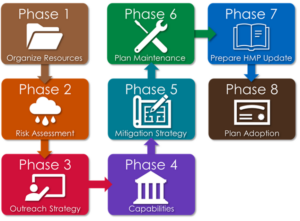Purpose
Rockland County is leading the update of its Hazard Mitigation Plan (HMP) for the County and participating jurisdictions. This plan is an opportunity to detail a variety of potential hazards that could affect some or all of our residents and will also allow plan participants to be eligible for future mitigation funding from the Federal Emergency Management Agency (FEMA). The goal of this plan is to identify projects that can reduce damages from future natural and non-natural hazards. The plan will include a risk assessment and a hazard mitigation strategy. The study will focus on existing buildings and potential future development, infrastructure, and critical facilities that might be impacted. Critical Facilities are those facilities considered critical to the health and welfare of the population and that is especially important following a hazard. Critical facilities include essential facilities, transportation systems, lifeline utility systems, high-potential loss facilities, and hazardous material facilities.
Scope
During the planning process, the Planning Partnership will actively be involving the private sector, non-profit, and other community partners in the planning process. The approach is consistent with the “Whole Community Approach,” which seeks to involve the entire community in disaster and hazard planning.
Objectives:
The objectives of the Rockland County HMP planning process are:
- Provide the public opportunities throughout the plan development and drafting process to provide input.
- Conduct a thorough risk assessment using the most recent disaster data and information.
- Formulate hazard mitigation goals, objectives, and actions as they relate to reducing loss of life and property from natural and human-caused hazards.
- Obtain state and federal approval of the HMP.
Hazard Mitigation Planning Process Summary:

This hazard mitigation planning process involves eight phases:
Phase 1: Organize Resources
Relevant studies, plans, and reports are collected along with communications resources that allow the public to be involved throughout the planning process. A planning team is “built” that consists of municipal representatives, and local and regional stakeholders.
Phase 2: Risk Assessment
Potential locations and geographic extent of natural and human-caused hazards that can affect the county are identified along with their impacts and future probability. Scientific and anecdotal evidence of past events is collected and evaluated, and the hazards and losses the community has sustained are ranked high to low.
Phase 3: Outreach Strategy
During this phase, a comprehensive public engagement strategy will be developed to educate and increase awareness of the HMP planning process. This will include a series of social media posts, a project information brochure, and public meetings.
Phase 4: Capabilities
Local capabilities in emergency management, the National Flood Insurance Program (NFIP), planning and regulatory authority, administrative and technical knowledge, finances, and education and outreach are assessed.
Phase 5: Mitigation Strategy
Goals, objectives, and actions are evaluated and updated as needed. The planning team defines appropriate mitigation techniques, and chooses and prioritizes mitigation actions and projects in the mitigation strategy.
Phase 6: Plan Maintenance
The HMP is a living document that must be regularly reviewed, updated, and maintained. A schedule including responsible parties or agencies involved with monitoring, evaluating, and updating the plan during its 5-year cycle is prepared. A process for integrating the updated Mitigation Strategy into existing plans and reports is outlined and a plan for continued public outreach and participation will also be determined.
Phase 7: Prepare HMP Update
The draft plan will be developed and assembled to meet all federal and state regulations.
Phase 8: Plan Adoption
The draft plan is made available for public comment and then submitted to NYSDHSES and FEMA for review and approval. Once the plan has been determined to meet all state and federal requirements and receives official approval, it should be adopted by all participating jurisdictions.
